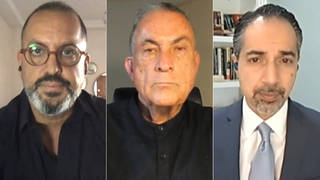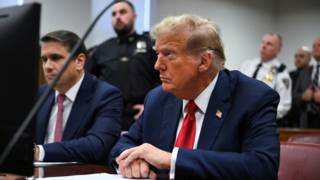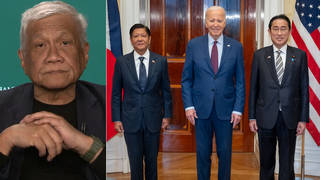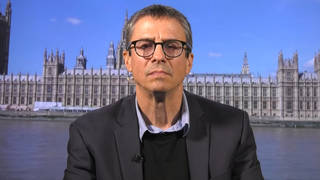
Related
The National Museum of the American Indian opened in Washington DC last week on the last spot on the National Mall. We speak with renowned Native American writer and scholar Paula Gunn Allen as well as a Native American artist who helped design the museum. [includes rush transcript]
As many as 10,000 Native Americans traveled to the nation’s capital of Washington DC last week for the opening of the * National Museum of the American Indian* — and for many of them, for the first time it truly was their capital.
Nestled between the Air and Space Museum and the Capitol, the museum of the American Indian takes up the last spot on the National Mall.
Visitors can see more than seven thousand objects in the new museum. Some of them more than ten thousand years old. Exhibits include food and stone carvings, face coverings from the northwest coast of North America. Clothing and head coverings made of animal skins and feathers from the North American plains. Clay pots, woven baskets and silver jewelry from the southwestern United States.
While many applaud the idea behind the Museum of the American Indian, some groups like the American Indian Movement says there is not enough information about abuses inflicted by the U.S government. The AIM is calling for the museum to be renamed the National Holocaust Museum of the American Indian.
- Paula Gunn Allen, Native American writer and scholar. She is an indigenous New Mexican of Laguna Pueblo/Metis and Sioux descent and is hailed as the founder of American Indian literary studies. She is a professor emerita of English at University of California, Los Angeles. Her latest book Pocahontas: Medicine Woman, Spy, Entrepreneur, Diplomat received a 2004 Pulitzer Prize nomination.
- Ramona Sakiestewa, design consultant for the National Museum of the American Indian. She is a Native American artist and designer of Hopie ancestry.
Transcript
AMY GOODMAN: We’re joined here in Albuquerque, New Mexico, by Paula Gunn Allen. She is a Native American writer and scholar, indigenous New Mexican of Laguna Pueblo and Sioux descent, hailed as the founder of American Indian Literary Studies. She is a Professor Emeritus of English at UCLA, University of California Los Angeles. Her latest book, Pocahontas: Medicine Woman, Spy, Entrepreneur, Diplomat, received a 2004 Pulitzer Prize nomination. We welcome you to Democracy Now! It’s great to have you with us. Can you respond to the establishment of this museum?
PAULA GUNN ALLEN: It’s an event I have been sitting here trying to think of what’s the word. I’m a poet and I cannot think of one. It creates in me and in everyone I have talked to since it opened, and I have been vaguely involved in it since the very beginning. I don’t know. It’s pride, it’s relief, it’s grief, it’s anguish, it’s joy, it’s beauty. I read some of the press releases, and they don’t like it because it doesn’t do white stuff. I’m rather interested that A.I.M. wants us to attack the United States, but you know, most of the folks don’t see any point in that. What’s important is that we’re here. We’re still occupied. There’s no post-colonial Native America. Nor will there ever be, unless all of you want to leave, but that’s not going to happen. So, what we have is our statement of how we are. That museum is about us telling each other about where we have been and what we have done, what’s been going on. And the outsiders are very unhappy that it doesn’t do what — it’s not scholarly enough or it’s not political enough or it’s not historical enough or it’s not ethnographic enough, it’s not white enough. As for the radical Indians, well, they have a point. They always have a point. I’m half in agreement with them, half of the time. But we are a little more conservative out here in the west. Actually, I have been back east and have talked to people from all kinds of tribes back there. It isn’t about confrontation to us. It’s about we’re here, and we’re not going anywhere. 400, 500 years, you cannot make us go away.
AMY GOODMAN: We’re also joined on the telephone by Ramona Sakiestewa. She is design consultant for the National Museum of the American Indian. She joins us from Santa Fe, where we were last night. You helped design this museum. Can you talk about its unusual design with no right angles, for example?
RAMONA SAKIESTEWA: Well, good morning. Yes, I would like to just play off of what Paula Gunn Allen said. The museum, even in its conceptual shape, reflects over 150 meetings with indigenous people from throughout the Americas. This was a collective vision. The shape is really in reference to the landscape and is carved from something that was — over time to make you remember wind and water and what it does to the landscape. There’s a great deal of memory inherent in the landscape itself about Washington long before it was Washington, D.C., but when it was a wetland.
JUAN GONZALEZ: Amy, I —
AMY GOODMAN: Can you just —
JUAN GONZALEZ: I’d like to ask —
AMY GOODMAN: Juan, go ahead.
JUAN GONZALEZ: Yes, I’d like to ask Ramona, in terms of the funding for the museum, did this come largely — was this the federal government or was it private sources? How did the idea and the — how did the museum come to life in terms of funding?
RAMONA SAKIESTEWA: It was — this is really a question for Rick West, but in generalities, it was the legislation for it was November 28, I believe, 1989, and the funding was both federal and had to be at least half privately funded, and I believe more than half was privately funded.
AMY GOODMAN: Well, Ramona Sakiestewa, designer for the National Museum of the American Indian, and Paula Gunn Allen, I want to thank you for being with us. I hope to have you back, Paula Gunn Allen, to talk about your book, to talk about Pocahontas and talk to about a different version of history in this country.












Media Options